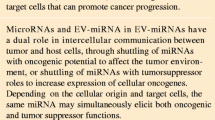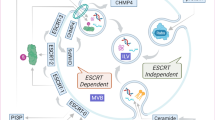Abstract
Tumor cells produce small extra cellular vesicles-(tsEV) massively, which act as cancer messengers that may also have anti-cancer effects. Based on this knowledge, we hypothesized that we can benefit from 4T1-derived sEVs to amplify the anti-cancer effects of miR-34a-replacement therapy in 4T1 cells. Supernatant of 4T1 cultured cells gathered after 24 h of exposure to serum-free media. tsEVs purified by commercial kit and characterized by transmission and scanning electron microscopy, dynamic light scattering, and bicinchoninic acid assay. Modified CaCl2 method applied for miR-34a loading in tsEV (tsEV-miR) and loading confirmation evaluated by the relative expression of miR-34a. MTT, annexin V/PI, cell cycle, scratch test, and real-time PCR were performed for proliferation, apoptosis, invasion, and relative expression of miR-34a target genes after treatment with tsEV/tsEV-miR, respectively. The results indicated that tsEV-miR provides a time–dose–dependent anti-proliferative effect versus tsEV/control group. tsEV-miR could induce apoptosis and arrest the cell cycle at G0/G1 phase, and moreover, it effectively halted the invasion capability of 4T1 cells. Treatment with tsEV-miR down-regulated miR-34a target genes, including B-cell lymphoma-2, vascular endothelial growth factor and its receptor, matrix metalloproteinase-2 and -9, and interleukin-6. Engineered tsEVs can affect different aspects of 4T1 cancer cells including proliferation, apoptosis, cell cycle, migration, and cancer-related gene expression profile. In this regard, tsEV could be considered a proper vehicle for miR-34a replacement therapy and could exacerbate its anti-cancer effects in triple-negative breast cancer. Indeed, TNBC can be targeted by multiple angles by its weapon.





Similar content being viewed by others
Data availability
The datasets related to findings of this research are available upon reasonable request from the corresponding author.
Abbreviations
- miR:
-
MicroRNA
- tsEV:
-
Tumor-derived small extra cellular vesicle
- tsEV-miR:
-
MiR-34a loaded tsEV
- DLS:
-
Dynamic light scattering
- TEM:
-
Transmission electron microscopy
- BCA:
-
Bicinchoninic acid assay
- BCL2:
-
B-cell lymphoma-2
- MMP-2,MMP-9:
-
Matrix metalloproteinase-2 and -9
- IL-6:
-
Interleukin-6
References
Sung H, Ferlay J, Siegel RL, Laversanne M, Soerjomataram I, Jemal A, Bray F. Global cancer statistics 2020: GLOBOCAN estimates of incidence and mortality worldwide for 36 cancers in 185 countries. CA. 2021;71(3):209–49.
Yagata H, Kajiura Y, Yamauchi H. Current strategy for triple-negative breast cancer: appropriate combination of surgery, radiation, and chemotherapy. Breast Cancer. 2011;18(3):165–73.
Yu Z, Baserga R, Chen L, Wang C, Lisanti MP, Pestell RG. microRNA, cell cycle, and human breast cancer. Am J Pathol. 2010;176(3):1058–64.
Svoronos AA, Engelman DM, Slack FJ. OncomiR or tumor suppressor? The duplicity of microRNAs in cancer. Can Res. 2016;76(13):3666–70.
Imani S, Wu R-C, Fu J. MicroRNA-34 family in breast cancer: from research to therapeutic potential. J Cancer. 2018;9(20):3765.
Hessvik NP, Llorente A. Current knowledge on exosome biogenesis and release. Cell Mol Life Sci. 2018;75(2):193–208.
Harding CV, Heuser JE, Stahl PD. Exosomes: looking back three decades and into the future. J Cell Biol. 2013;200(4):367.
Raposo G, Stoorvogel W. Extracellular vesicles: exosomes, microvesicles, and friends. J Cell Biol. 2013;200(4):373–83.
Leidal AM, Debnath J. Emerging roles for the autophagy machinery in extracellular vesicle biogenesis and secretion. FASEB BioAdv. 2021;3(5):377–86.
Baixauli F, López-Otín C, Mittelbrunn M. Exosomes and autophagy: coordinated mechanisms for the maintenance of cellular fitness. Front Immunol. 2014;5:403.
Qiao L, Hu S, Huang K, Su T, Li Z, Vandergriff A, Cores J, Dinh P-U, Allen T, Shen D. Tumor cell-derived exosomes home to their cells of origin and can be used as Trojan horses to deliver cancer drugs. Theranostics. 2020;10(8):3474.
Zhang D, Lee H, Zhu Z, Minhas JK, Jin Y. Enrichment of selective miRNAs in exosomes and delivery of exosomal miRNAs in vitro and in vivo. Am J Physiol-Lung Cell Mol Physiol. 2017;312(1):L110–21.
Li Z, Chen H. miR-34a inhibits proliferation, migration and invasion of paediatric neuroblastoma cells via targeting HNF4α. Artif Cells Nanomed Biotechnol. 2019;47(1):3072–8.
Rui X, Zhao H, Xiao X, Wang L, Mo L, Yao Y. MicroRNA-34a suppresses breast cancer cell proliferation and invasion by targeting Notch1. Exp Ther Med. 2018;16(6):4387–92.
Wang J-X, Zhang Q-J, Pei S-G, Yang B-L. Effect and mechanism of miR-34a on proliferation, apoptosis and invasion of laryngeal carcinoma cells. Asian Pac J Trop Med. 2016;9(5):494–8.
Hosseini M, Baghaei K, Amani D, Ebtekar M (2021) Tumor-derived exosomes encapsulating miR-34a promote apoptosis and inhibit migration and tumor progression of colorectal cancer cells under in vitro condition. DARU J Pharm Sci 1–12
Ji X, Wang Z, Geamanu A, Goja A, Sarkar FH, Gupta SV. Delta-tocotrienol suppresses Notch-1 pathway by upregulating miR-34a in nonsmall cell lung cancer cells. Int J Cancer. 2012;131(11):2668–77.
Lai M, Du G, Shi R, Yao J, Yang G, Wei Y, Zhang D, Xu Z, Zhang R, Li Y. MiR-34a inhibits migration and invasion by regulating the SIRT1/p53 pathway in human SW480 cells. Mol Med Rep. 2015;11(5):3301–7.
Kumar B, Yadav A, Lang J, Teknos TN, Kumar P. Dysregulation of microRNA-34a expression in head and neck squamous cell carcinoma promotes tumor growth and tumor angiogenesis. PLoS ONE. 2012;7(5):e37601.
Ding G, Zeng Y, Yang D, Zhang C, Mao C, Xiao E, Kang Y, Shang J. Silenced lncRNA DDX11-AS1 or up-regulated microRNA-34a-3p inhibits malignant phenotypes of hepatocellular carcinoma cells via suppression of TRAF5. Cancer Cell Int. 2021;21(1):1–13.
Sharma S, Patnaik PK, Aronov S, Kulshreshtha R. ApoptomiRs of breast cancer: basics to clinics. Front Genet. 2016;7:175.
Li L, Yuan L, Luo J, Gao J, Guo J, Xie X. MiR-34a inhibits proliferation and migration of breast cancer through down-regulation of Bcl-2 and SIRT1. Clin Exp Med. 2013;13(2):109–17.
Strzalka W, Ziemienowicz A. Proliferating cell nuclear antigen (PCNA): a key factor in DNA replication and cell cycle regulation. Ann Bot. 2011;107(7):1127–40.
Zhang D, Zhou J, Dong M. Dysregulation of microRNA-34a expression in colorectal cancer inhibits the phosphorylation of FAK via VEGF. Dig Dis Sci. 2014;59(5):958–67.
Shi S, Jin Y, Song H, Chen X. MicroRNA-34a attenuates VEGF-mediated retinal angiogenesis via targeting Notch1. Biochem Cell Biol. 2019;97(4):423–30.
Mansoori B, Silvestris N, Mohammadi A, Khaze V, Baghbani E, Mokhtarzadeh A, Shanehbandi D, Derakhshani A, Duijf PH, Baradaran B. miR-34a and miR-200c have an additive tumor-suppressive effect on breast cancer cells and patient prognosis. Genes. 2021;12(2):267.
Wang X, Chen X, Sun L, Bi X, He H, Chen L, Pang J. MicroRNA-34a inhibits cell growth and migration in human glioma cells via MMP-9. Mol Med Rep. 2019;20(1):57–64.
Yang L, Song X, Zhu J, Li M, Ji Y, Wu F, Chen Y, Cui X, Hu J, Wang L. Tumor suppressor microRNA-34a inhibits cell migration and invasion by targeting MMP-2/MMP-9/FNDC3B in esophageal squamous cell carcinoma. Int J Oncol. 2017;51(1):378–88.
Chou KY, Chang AC, Tsai TF, Lin YC, Chen HE, Ho CY, Chen PC, Hwang TI. MicroRNA-34a-5p serves as a tumor suppressor by regulating the cell motility of bladder cancer cells through matrix metalloproteinase-2 silencing. Oncol Rep. 2021;45(3):911–20.
Masjedi A, Hashemi V, Hojjat-Farsangi M, Ghalamfarsa G, Azizi G, Yousefi M, Jadidi-Niaragh F. The significant role of interleukin-6 and its signaling pathway in the immunopathogenesis and treatment of breast cancer. Biomed Pharmacother. 2018;108:1415–24.
Klasson M, Lindberg M, Särndahl E, Westberg H, Bryngelsson I-L, Tuerxun K, Persson A. Dose-and time-dependent changes in viability and IL-6, CXCL8 and CCL2 production by HaCaT-cells exposed to cobalt. Effects of high and low calcium growth conditions. PLoS ONE. 2021;16(6):e0252159.
Bhatta B, Cooks T. Reshaping the tumor microenvironment: extracellular vesicles as messengers of cancer cells. Carcinogenesis. 2020;41(11):1461–70.
Gudbergsson JM, Johnsen KB. Exosomes and autophagy: rekindling the vesicular waste hypothesis. J Cell Commun Signaling. 2019;13(4):443–50.
Galluzzi L, Baehrecke EH, Ballabio A, Boya P, Bravo-San Pedro JM, Cecconi F, Choi AM, Chu CT, Codogno P, Colombo MI. Molecular definitions of autophagy and related processes. EMBO J. 2017;36(13):1811–36.
Kalra H, Simpson RJ, Ji H, Aikawa E, Altevogt P, Askenase P, Bond VC, Borràs FE, Breakefield X, Budnik V. Vesiclepedia: a compendium for extracellular vesicles with continuous community annotation. PLoS Biol. 2012;10(12):e1001450.
Haraszti RA, Miller R, Dubuke ML, Rockwell HE, Coles AH, Sapp E, Didiot M-C, Echeverria D, Stoppato M, Sere YY. Serum deprivation of mesenchymal stem cells improves exosome activity and alters lipid and protein composition. Iscience. 2019;16:230–41.
Luo M, Zhao X, Song Y, Cheng H, Zhou R. Nuclear autophagy: an evolutionarily conserved mechanism of nuclear degradation in the cytoplasm. Autophagy. 2016;12(11):1973–83.
Takahashi A, Okada R, Nagao K, Kawamata Y, Hanyu A, Yoshimoto S, Takasugi M, Watanabe S, Kanemaki MT, Obuse C. Exosomes maintain cellular homeostasis by excreting harmful DNA from cells. Nat Commun. 2017;8(1):1–16.
Khalilnezhad A, Mahmoudian E, Mosaffa N, Anissian A, Rashidi M, Amani D. Effects of Chlorella vulgaris on tumor growth in mammary tumor-bearing Balb/c mice: discussing association of an immune-suppressed protumor microenvironment with serum IFNγ and IgG decrease and spleen IgG potentiation. Eur J Nutr. 2018;57(3):1025–44.
Acknowledgements
This article has been extracted from the thesis written by Ms. Mahsa Hajivalili in School of Medicine, Shahid Beheshti University of Medical Sciences (Registration No: 391). Ethics committee approval ID was IR.SBMU.MSP.REC.1398.581
Funding
This research was financially supported by the Shahid Beheshti University of Medical Sciences under Grant [No. 20846].
Author information
Authors and Affiliations
Contributions
MH involved in investigation, visualization, formal analysis, data curation, and writing -original draft. KB participated in visualization and writing -review and editing. NM took part in resources, writing-review & editing. BN performed visualization. DA carried out conceptualization, project administration, funding acquisition, writing-review & editing, supervision, and validation. All authors contributed to the article and approved the submitted version.
Corresponding author
Ethics declarations
Competing interest
The authors have no relevant financial or non-financial interests to disclose.
Additional information
Publisher's Note
Springer Nature remains neutral with regard to jurisdictional claims in published maps and institutional affiliations.
Rights and permissions
About this article
Cite this article
Hajivalili, M., Baghaei, K., Mosaffa, N. et al. Engineering tumor-derived small extra cellular vesicles to encapsulate miR-34a, effectively inhibits 4T1 cell proliferation, migration, and gene expression. Med Oncol 39, 93 (2022). https://doi.org/10.1007/s12032-022-01685-0
Received:
Accepted:
Published:
DOI: https://doi.org/10.1007/s12032-022-01685-0




